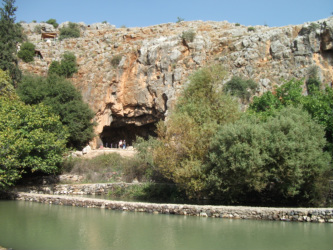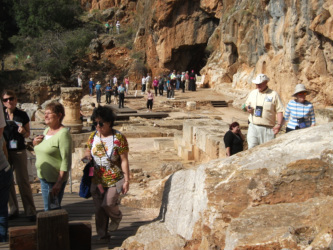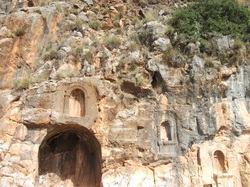Caesarea Philippi

Gospel of Matthew 16:13-19
Now when Jesus came into the district of Caesarea Philippi, he asked his disciples, "Who do men say the Son of man is?" And they said, "Some say John the Baptist, others say Elijah, and others Jeremiah or one of the prophets." He said to them, 'But who do you say that I am?' Simon Peter replied, You are the Christ, the Son of the living God." And Jesus answered him, "Blessed are you Simon Bar-Jona. For flesh and blood has not revealed this to you, but my Father who is in heaven. And I tell you, you are Peter and on this rock I will build my church, and the powers of death shall not prevail against it. I will give you the keys of the kingdom of heaven, and whatever you bind on earth shall be bound in heaven, and whatever you loose on earth shall be loosed in heaven."
Now when Jesus came into the district of Caesarea Philippi, he asked his disciples, "Who do men say the Son of man is?" And they said, "Some say John the Baptist, others say Elijah, and others Jeremiah or one of the prophets." He said to them, 'But who do you say that I am?' Simon Peter replied, You are the Christ, the Son of the living God." And Jesus answered him, "Blessed are you Simon Bar-Jona. For flesh and blood has not revealed this to you, but my Father who is in heaven. And I tell you, you are Peter and on this rock I will build my church, and the powers of death shall not prevail against it. I will give you the keys of the kingdom of heaven, and whatever you bind on earth shall be bound in heaven, and whatever you loose on earth shall be loosed in heaven."
Ruins of the temple

Commentary: Jesus walked with his disciples for days into the mountains to
deliver this teaching at just the right location. It took place on Mount Hermon
at the source of the Jordan River, where a great rock stood about 100 feet high
and 500 feet wide, on which stood a "false" temple, dedicated formerly to the
god of sheep and shepherds, the Greek god, Pan, a false god. At the time there probably stood a Roman temple dedicated to Caesar Augustus at or near this location. Jesus, the Good Shepherd and the true Temple, contrasted his Church with that of the false temple of Pan/Caesar and made Peter, the rock on which the Church was founded (Matthew 16:18) and gave him the keys to the kingdom of heaven. Remember that Abraham was also referred to as the rock (Isaiah 51: 1) and had his name changed as did Simon Peter. Why would Jesus make Peter the rock and give him the keys?
The reason is important to our understanding. Jesus ascended into heaven 40 days after his Resurrection and he left the Apostles as his shepherds, with Peter at their head, to build the Church with the help of the promised Holy Spirit, the Advocate He promised to send the Holy Spirit (John 14: 15-17, 25). Remember too that the parables and message of Jesus in the Gospel of Matthew is centered on the Kingdom of God or heaven. This is our true home with Christ our Savior!
Jesus, thus, provided for His Church and at a location which made His words unforgettable to the Apostles, who had climbed up into the mountains (the highest in Israel) for three days to hear this important teaching from Him. The authority he gave the Church is reflected in the teaching office of the Catholic Church (the magisterium). Pope Francis is the current key holder and vicar of Christ. He is the 266th holder of this office. Jesus founded only one Church. The New Testament often focused on the need for unity in the Church (John 10:16, 17:17-23, Ephesians 4: 3-6, Romans 12: 5, 16:17, 1 Corinthians 1:10, 12:13, etc.). The Holy Father is the symbol and vicar of that unity in the Body of Christ, which is the Catholic (universal) Church.
deliver this teaching at just the right location. It took place on Mount Hermon
at the source of the Jordan River, where a great rock stood about 100 feet high
and 500 feet wide, on which stood a "false" temple, dedicated formerly to the
god of sheep and shepherds, the Greek god, Pan, a false god. At the time there probably stood a Roman temple dedicated to Caesar Augustus at or near this location. Jesus, the Good Shepherd and the true Temple, contrasted his Church with that of the false temple of Pan/Caesar and made Peter, the rock on which the Church was founded (Matthew 16:18) and gave him the keys to the kingdom of heaven. Remember that Abraham was also referred to as the rock (Isaiah 51: 1) and had his name changed as did Simon Peter. Why would Jesus make Peter the rock and give him the keys?
The reason is important to our understanding. Jesus ascended into heaven 40 days after his Resurrection and he left the Apostles as his shepherds, with Peter at their head, to build the Church with the help of the promised Holy Spirit, the Advocate He promised to send the Holy Spirit (John 14: 15-17, 25). Remember too that the parables and message of Jesus in the Gospel of Matthew is centered on the Kingdom of God or heaven. This is our true home with Christ our Savior!
Jesus, thus, provided for His Church and at a location which made His words unforgettable to the Apostles, who had climbed up into the mountains (the highest in Israel) for three days to hear this important teaching from Him. The authority he gave the Church is reflected in the teaching office of the Catholic Church (the magisterium). Pope Francis is the current key holder and vicar of Christ. He is the 266th holder of this office. Jesus founded only one Church. The New Testament often focused on the need for unity in the Church (John 10:16, 17:17-23, Ephesians 4: 3-6, Romans 12: 5, 16:17, 1 Corinthians 1:10, 12:13, etc.). The Holy Father is the symbol and vicar of that unity in the Body of Christ, which is the Catholic (universal) Church.
 Niches in the rock used to house images of the "god" Pan
Niches in the rock used to house images of the "god" Pan
Comment by the Holy Father
“ … I would like to draw attention to the geographical and chronological context of these words ( i.e., Matthew 16: 16-19). The promise was made near the source of the Jordan (River), at the border of Jewish land, on edge of the pagan world. … He (Jesus) tells His disciples that this journey towards the Holy City is a journey to the Cross.”
[Homily of Pope Benedict XVI on the Solemnity of Saints Peter and Paul, June 29, 2006.]
